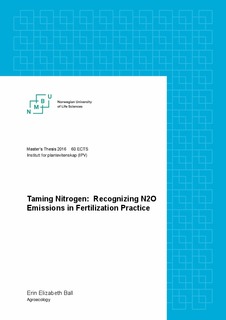Taming nitrogen : recognizing N2O emissions in fertilization practice
Master thesis
Permanent lenke
http://hdl.handle.net/11250/2398768Utgivelsesdato
2016-08-11Metadata
Vis full innførselSamlinger
- Master's theses (IPV) [240]
Sammendrag
Atmospheric nitrous oxide (N2O) is a greenhouse gas resulting from an imbalanced global nitrogen cycle. Although agricultural soils emit the majority of anthropogenic N2O, it is rarely considered in soil management practice. To understand why, this thesis explored the social constructs of nitrogen management through a case study contrasting practices and attitudes from three schools of thought with different approaches to soil fertility management: precision, organic, and no-till with cover crops; and from the perspective of different roles in agriculture from farming and advising to science and industry. Nitrogen management practices were compared using a model from organizational theory in which problems and solutions are inconsistently matched. All schools of thought had approaches to balance yield and nitrogen conservation, and a prominent best practice was maximizing nitrogen use efficiency (NUE) as much as possible within the limits of acceptable yield. By reducing nitrogen flux, this reduces N2O. A sense of minimizing entropy – nitrogen losses inherent in conversions and storage between its many chemical forms – could further reduce N2O emissions. Though how to accomplish this is technologically unclear at present, a future state can be developed from currently evolving fusions between a mainstreaming soil health movement, a maturing practice of intensive cover crops, supportive technologies of soil testing, sensing and modeling which increasingly capture nitrogen dynamics, and the emerging technology of precision nitrogen sensing and management.

